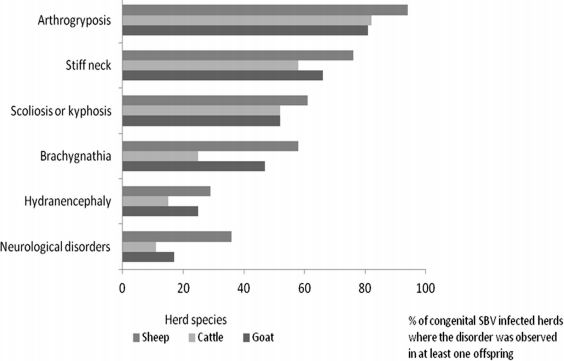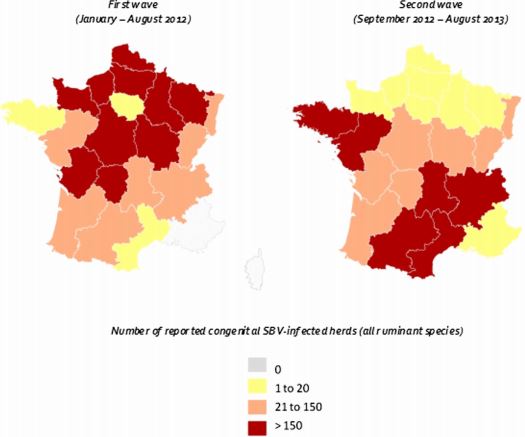



Schmallenberg Virus And its French Effect
A team of French scientists have analysed farm records to assess how Schmallenberg virus spread across the country.Monitoring data collected from January 2012 to August 2013 gives an impression of how Schmallenberg Virus (SBV) spread through naive French sheep and cattle, sweeping across the north east of the country.
The Biomedcentral study links SBV with preceding midge activity and described morbidity levels as generally 'moderate'.
Spread Of SBV
Epidemic Number of reported outbreaks
The number of outbreaks of congenital SBV reported through surveillance provides important indications about trends in the SBV epidemic but does not provide an accurate estimate of the number of herds that were actually infected by SBV, as some of the SBVinfected herds were either not detected (i.e. infection of non-pregnant ruminants, infection of pregnant ruminants that were not in the susceptible stage of gestation) or not reported.
Moreover, under-reporting of congenital SBV may have increased from September 2012 onwards since SBV was no longer a notifiable disease in France, and costs of laboratory analysis for confirmation were sometimes incurred by the farmers.
Temporal patterns of spread
Extrapolation of the estimated dates of foetal infection from the dates of birth would indicate that the first reported cases of congenital SBV in France in small ruminants in January 2012 must have resulted from infections that occurred in September or October 2011, while the first reported cases in calves in January 2012 must have resulted from infections from June to October 2011.
This suggests that the circulation of SBV in France started in October 2011, at the latest. On the other hand, retrospective serosurveys carried out in two French departments (Meurthe-et-Moselle in north-eastern France where congenital SBV cases were first confirmed in January 2012, and Manche in north-western France where congenital SBV cases were first confirmed in February 2012) showed that SBV was circulating in these departments in October 2011, while the virus was not detected from serum samples collected in August or September 2011.
All together, these data suggest that SBV was not present in France before September 2011. The seasonality in the number of reported congenital SBV-infected herds is consistent with the seasonality in midge vector activity: each wave of congenital SBV corresponds to cases of congenital SBV resulting from foetal infections that occurred during the previous vector season.
The two waves of congenital SBV started approximately at the same period for cattle and small ruminants. This observation is consistent with the minimal interval between foetal infection and birth, which is estimated to be similar for the different ruminant species (three months).
It is however noticeable that the epidemic peaked three months later in cattle than in small ruminants, which is due to the longer gestation period and the longer time period during which transplacental infection can lead to foetal damage.
The second epidemic wave of congenital SBV began and peaked about four months earlier than the first wave, probably due to an earlier onset of viral circulation in the vector season in 2012 (spring) than in 2011 (autumn).
Spatial patterns of spread
The spatial distribution of congenital SBV incidence rates cannot be assessed through surveillance, due on the one hand to the underestimation of the number of infected herds, and on the other hand to the lack of knowledge of the number of susceptible herds (i.e. with pregnant ruminants in the susceptible stage of gestation).
However, congenital SBV surveillance data still provide valuable information on the trends of the epidemic’s spread. The findings indicate that the virus spread rapidly across north-eastern France during the first wave.
Consistently, serosurveys conducted during the spring of 2012 indicated that SBV within-herd seroprevalence was high in north-eastern France. In that area, outbreaks of congenital SBV were reported rather sporadically during the second wave.
Numerous infected herds were identified in southern and western parts of the territory during the second wave.
Providing that SBV infection results in long-term protective immunity, and despite considerable uncertainty concerning the level of immunity at the population level in the infected areas, the epidemic peak of congenital SBV seems behind us, even if sporadic outbreaks of congenital SBV resulting from the infection of previously unexposed animals are still being reported during the third epidemic wave.
As of the 15th of August 2014, 108 congenital SBV-infected herds had been reported throughout France since the first of September 2013 during surveillance of the third wave. Comparatively, 2,976 congenital SBV-infected herd were reported during thefirst wave, and 1,834 during the second wave.
Conclusion
SBV rapidly spread across France upon its emergence in the autumn of 2011. After two seasons of SBV circulation, all the regions had been infected. France continues to monitor congenital SBV outbreaks, and updated information is made available online on a regular basis [http://www.plateforme-esa.fr/]. Outbreaks of congenital SBV may occur sporadically from now on, unless further epidemics occur if the immunity at population level declines.




